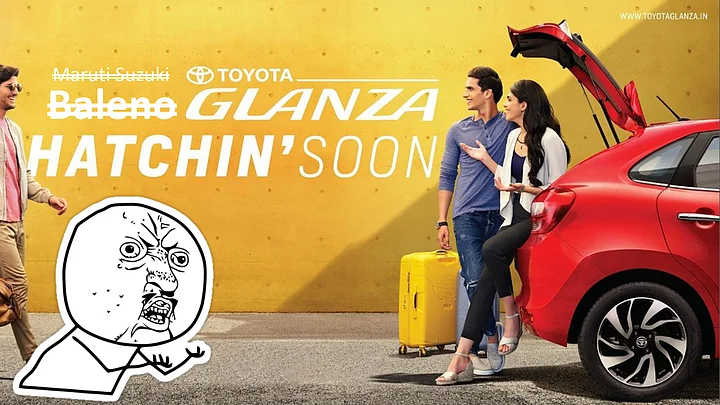(This story has been updated after Toyota announced the availability and pricing of Glanza for the Indian consumers on Thursday.)
Toyota has launched the Baleno-looking Glanza hatchback in the Indian market, with its introductory prices starting from Rs 7.22 lakh (ex-showroom), putting few grands lower than what you’d pay Maruti’s Baleno right now.
So, how is Toyota selling a car in India that looks exactly like the Baleno? The answer to that is badge engineering – a term used in the automotive industry for when one company picks another company’s product and just slaps on its own name to sell it as a different car.
Yes, that’s exactly what the Toyota Glanza is: A re-badged Maruti Suzuki Baleno.
Now, this news does not come as a surprise at all. A few months ago Toyota and Maruti Suzuki inked a deal to share cars and push electric vehicle technology.
The deal is multi-faceted and involves sharing of products from both companies for different markets.
The Toyota-Suzuki Deal
- Toyota will supply its hybrid system to Suzuki for global markets
- Toyota will source hybrid-electric system locally in India
- Suzuki will sell Toyota’s RAV4 and Corolla wagon in Europe
- Suzuki to supply Ciaz and Ertiga to Toyota to re-badge and sell in India
- Toyota to start using newly developed engines by Suzuki and make them in Poland
- Toyota to sell Suzuki’s Baleno, Vitara Brezza, Ciaz and Ertiga as Toyota vehicles in Africa
- Suzuki to manufacture a C-segment Toyota MPV and sell in India
- From 2022, Suzuki Vitara Brezza to be made by Toyota in Bengaluru
The Maruti Suzuki Baleno is the first vehicle that will go to Toyota and will be sold in India as well as other markets as the Toyota Glanza. This will give Toyota a product to sell in the premium hatchback space besides the Liva.
The Toyota Glanza will compete with the Maruti Suzuki Baleno in the market, although Toyota is likely to only sell the top two variants, with some cosmetic updates to the grille and alloys. There’s no clarity on the engine that will be offered, but it could be the new dual-jet petrol that Maruti introduced recently.
How will this go down with customers? We are not sure at the moment.
Previous Badge-Engineered Products
Badge engineering hasn’t always worked well in the Indian market. Nissan and Renault did this with many of their products with limited success.
The Nissan Micra was re-badged and sold as a the Renault Pulse in India. It didn’t fare well and was discontinued. The Nissan Sunny was re-badged and sold as the Renault Scala in India, with limited success.
The Renault Duster was given some cosmetic treatment and sold as the Nissan Terrano in India, but it wasn’t as successful as the Renault Duster.
The Nissan Evalia van was also made by Ashok Leyland for the commercial market and sold as the Ashok Leyland Stile, but neither of them were successful.
Forget the domestic market. Car makers also resort to badge engineering products across markets.
The Suzuki WagonR, for instance, is sold as the Mazda Flair in Japan. The Daewoo Matiz was sold as the Chevrolet Spark in India after Daewoo exited. The upcoming MG Hector is sold as the Baojun 530 in China.
There are plenty of examples of such badge engineering. The question remains – will the Toyota Glanza sell as much as the Maruti Baleno does in India, which is over 10,000 units a month?
(At The Quint, we question everything. Play an active role in shaping our journalism by becoming a member today.)
